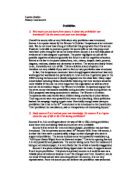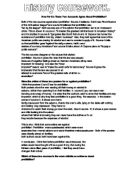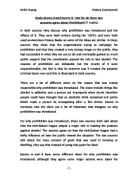The information in Sources D and E strongly back up the evidence in Source B. Source D is a caption from a book published in 1930 and it states that underpaid Prohibition agents (those hired by the US government to impede alcohol activity) are very unlikely able to “resist corruption” by rich men who wanted alcohol and could bribe police into allowing them to get what they want in exchange for a hefty pay-off. This shows that it must have been difficult to keep track of alcohol abuse with corrupt Prohibition agents.
Source E is a table that shows arrests for drinking offences in Philadelphia from 1920-25. These statistics show an increasing rise each year of drink related offences. Again this reveals an increase is illegal drink offences, which is making it a whole lot more difficult for Uncle Sam (American government) to crack down on the bottles (alcohol).
3. Study sources B, D and H, and use your own knowledge. Use sources D and H, and your own knowledge to explain why the life described in Source B did not come about.
The life described in Source B did not come to pass because of the American’s wanting alcohol even though it was illegal. Banning alcohol was not a simple task to achieve. Alcohol was more than just a drink; it was a way of life. It was hoped that by making drinking illegal, America would be a better, safer and fairer place to live in. Sadly, this was not the case. Within a short space of time American society did change, but not for the better. Gangsters, already making an illegal living out of prostitution and gambling, made even more money in the illegal trade of alcohol. Gangsters were very successful in breaking the law; there were many reasons for this. One of which being that they bribed Prohibition agents to look the other way, allowing the gangsters to continue the highly illegal yet profitable trade of alcohol. They also bribed magistrates to give any gangsters who were caught and taken to court either light prison terms or sometimes none at all. This in hindsight would ensure that gangsters and those working for them could return to work as soon as possible. In doing so, the magistrate enabled the trade in alcohol to continue. Gangsters famously used violence to intimidate people to turn a blind eye to what they were doing.
America had long borders with ‘un-prohibited’ countries (or ‘wet’ countries as they were called) and long coastlines, both of which made smuggling immensely easy. Another reason as for why gangsters found it so easy to break the law was mainly because many ordinary people wanted alcohol and they in return provided a large and reliable market for the gangsters’ alcohol. This was definitely a clear case of supply and demand. Gangsters were satisfying the public’s demand for alcohol.
As a result of the lack of enforcement of the Prohibition act and the creation of an illegal industry, an increase in crime occurred. The ‘Prohibitionists’ hoped that the Volstead act would decrease drunkenness in America and therefore decrease the crime rate, especially in large cities. Although towards the beginning of Prohibition – this purpose seemed to be fulfilled, the crime rate soon skyrocketed to nearly twice of that of the pre-Prohibition era. There was nearly a 78% increase of homicide during Prohibition in the big cities.”
“Seldom has law been so flagrantly violated. Not only did Americans continue to manufacture, barter and posses alcohol: they drank more of it.” – Bowen
Although one would think that Prohibition would enhance the difficulty of obtaining alcohol, it was actually easy to obtain. The bootlegging business was so immense that customers could easily get hold of alcohol by almost simply walking down the street. Replacing saloons (which were all shut down at the start of Prohibition) were illegal speakeasies. These speakeasies were hidden in basements, office buildings and anywhere that could be found and admitted only those with member ship cards. It is obvious that Prohibition started out as a noble experiment but turned out to not be so noble but rather a failure on all accounts. People just did not like the Volstead act. Reasonable measures were not taken to enforce the laws and so they were practically ignored. Not only was Prohibition ineffective, it was also in a sense damaging to people and society. It is extremely difficult and unworkable for the police or officials to enforce a law, which is disrespected as well as disliked.
Life described in Source B did not come to pass because of these reasons. Sources D and H link with these reasons in saying people and especially gangsters did not respect, let alone abide by the Prohibition law.
4. Study sources F, G, I and J. How useful are these sources in helping you to understand the public attitudes to Prohibition in the 1920’s and early 1930’s?
Sources G, I, F and J are not really that useful in helping on to understand the public attitudes to Prohibition in the 1920’s and early 1930’s. Source F is from a New York composer (obviously a general member of the public) written in the 1950’s. He spoke about life in a speakeasy and it’s atmosphere. This source is not very reliable due to the fact it was written quite a long time after the actual Prohibition era took place. This makes it a secondary source. Nonetheless it does give a round about idea about what speakeasies were really about. Source G is an extract from a book written by a journalist 1n 1931, which is a biography on Al Capone. It recalls about exactly how Capone took advantage of the newly enforced Prohibition law and made money out of the unsteady situation. This source is slightly biased towards Al Capone. The writer tries to persuade the reader to believe that Al Capone was an average, run-of-the-mill businessman who managed to take complete control over an entire suburb of Chicago. The source shows the journalist was in favour of Capone supplying the public alcohol by saying that “Capone acquired more finesse” meaning that he though Capone was not so much a murderous killer but more a classy businessman. The source does, on the other hand give the reader a good insight into Capone’s activities by revealing that he bribes politicians into getting what he wanted.
Source I is a rather cheeky looking photograph of Al Capone from the front cover of a leading US weekly magazine called Time. Beneath the photograph there is a caption that says “Alphonse ‘Scarface’ Capone – A pink apron, a pan of spaghetti.” This source again shows Capone as a respectable person because of the fact Capone is looking very mischievous and playful, like your typical Italian man who worries about their spaghetti. This in retrospect conveys the notion that Capone was a buoyant Italian man solely interested in his cuisine (spaghetti) but in real fact he was cold-blooded murderer and criminal, which makes this source misleading and biased towards Capone. A year before this magazine was published, the Valentine massacre occurred in which Capone and his men slaughtered his rival gangs’ men. Capone was an actual murderer and a non-blasé criminal, but this source portrays him as none of these things. Time magazine is an internationally known magazine, which is read throughout the world and source I would’ve obviously given the general public a false impression of Capone.
Source J is a quote from President Roosevelt, after announcing the repeal of the 18th Amendment in 1933. He states, “I think this will be a good time for a beer”. The President is a person who is supposed to uphold a law and source J obviously shows us that Roosevelt did not respect the Prohibition law. This source then shows us that the President did not regard the 18th Amendment after all; he was not the President who passed it. He did nonetheless repeal this law a year after he came into power.
In conclusion, these sources do not show me public attitudes towards Prohibition in the 1920’s and early 1930’s. There were no first hand accounts from an average citizen or member of the public. Journalists or those in the journalism field mainly wrote these sources and journalists have the reputation for being extremely biased towards one side of an argument and their job is to change people’s opinion on certain issues and therefore these sources show no historical balance.
5. Study all the Sources and use your own knowledge. ‘Al Capone was viewed by the authorities in the USA as Public Enemy Number One’. Use the sources and your own knowledge to explain whether you agree with this view.
Al Capone in my personal opinion was a criminal and a murderer. He was not a good man. Nevertheless, he did ultimately know what the people wanted but were too scared to ask for. If he did not create an illegal business out of alcohol, someone else was bound to.
Al Capone saw himself as simply – a businessman and not a gangster, which is what he really was and he knew it. By calling himself a businessman, he gave himself a justification of exploiting the people of Chicago. In source H he says, “I call myself a businessman”. He made money out of a sheer case of supply and demand – he made business out of his own people. As profits from alcohol increased, the young Capone became particularly expert in the management of politicians. Sources G and D back this opinion up. Capone’s actions strongly support the idea that he saw himself as a businessman because he monopolised the entire town of Chicago by supplying what the people wanted, bribing the police, politicians etc. Chicago was bent to his will. Moreover, businessmen do not need to resort to murder to run a successful business. All the evils of Prohibition were symbolised by the figure of Al Capone.
Although he was a pander, a dope peddler, a racketeer, a briber, an extortionist, and a savage and merciless murderer, Capone ironically became one of the great popular heroes of his time. Millions of Americans ignored his crimes and admired him for disdaining a law, which was increasingly becoming unpopular, letting them bring in alcohol so they could sell it. Source F backs this up.
Capone reached celebrity status. In Chicago he was rich and powerful. He had bodyguards and was known by everyone (source J). His rival gang leader, Bugs Moran and him were in the height of gang wars. Bug’s shot one of Capone’s men and Capone got his revenge. Seven of Bug’s leading men were murdered in their meeting place in the St Valentine’s massacre. Moran arrived late to the meeting and therefore missed the annihilation.
Capone corrupted and bribed police chiefs and politicians. This was an amazingly easy task for him to achieve seeing as Prohibition agents were paid a pittance and were few and far between. He bribed them to look the other way, allowing him to continue the highly illegal trade of alcohol of which was highly profitable. This shows that the agents were easily influenced and they lacked morals and were more interested in earning higher earnings.
Capone, in the subject of illegal alcohol service, was providing a popular service. He used and abused the fact people wanted alcohol and was making money out of cheap temptation.
FDR was quoted saying he wanted a beer (source J). This, in a way still makes Capone looks good because if even the President was quoted saying he wanted a beer – doe it actually mean Capone was a bad person. The answer to this is simple. In my opinion, the Prohibition law was a pointless idea that brought out more evil than good. FDR shared this viewpoint but this did not make Capone a good person because he was still breaking a law, never mind it being unpopular and disrespected.
In conclusion, I do not agree with the viewpoint that the US authorities saw Capone as ‘Public Enemy Number One’ because the authorities were his puppets in aiding him to create an illegal business. He bribed those authorities and retrospectively they were actually working for him.
BIBLIOGRAPHY
- GCSE: Voices from the Past - Prohibition & Crime by John Simkin
- Ardent Spirits: The Rise and Fall of Prohibition by John Kobler
- The USA: A Divided Union by Neil DeMarco







